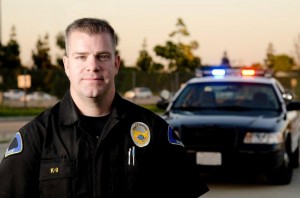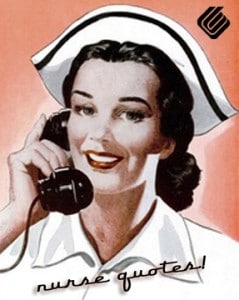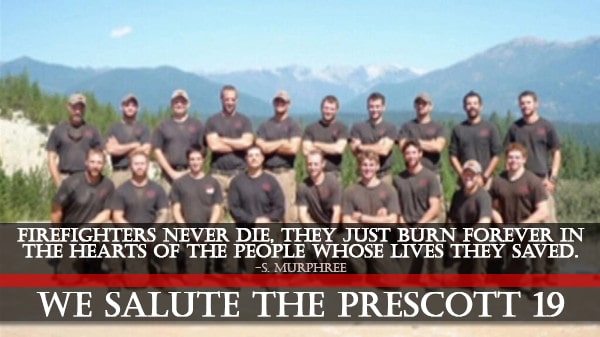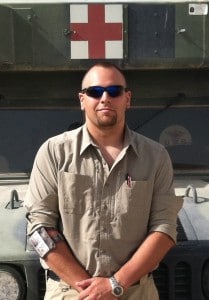by California Casualty | Safety |

There are many dangers associated with being a law enforcement officer. Many come simply from driving. The police have to protect the public but also protect themselves by not taking risks while in or around their vehicle. Here is a roundup of eight ways for police officers to keep safe on the job.
1. Don’t drive tired: It’s been proven that driving fatigued can be as bad as driving drunk. You’re especially at risk if you work overnight; the darkness can make anyone want to doze. Recognize the warning signs and know when you need to take a break: eyes closing or going out of focus, persistent yawning, irritability and wandering thoughts, among others.
2. Wear a seatbelt: This should go without saying, but it doesn’t. Not only is it a good example for the public, it is a no-brainer for keeping officers safe on the roadways. Sadly, almost half of officers killed in vehicle accidents were not wearing a seatbelt.
3. Use GPS: 911 dispatchers can use GPS to see where officers’ vehicles are at all times. Not only does it allow for the monitoring of safe driving habits, a live map shows the dispatcher which officer is nearest to the scene of an emergency. GPS speeds up the decision-making process, saving what can be critical moments, and the operator can send an officer who can get to the incident the soonest. As always, be sure officers are trained on any new technology in the vehicle, such as GPS-enabled laptops.
4. Avoid multitasking: Police officers today are outfitted with all kinds of equipment in their vehicles, including cameras and computers. Use extreme caution if you have to use this technology while behind the wheel. Eating, drinking or having a conversation while driving can be distracting, too. If it’s not an emergency situation, stop the car and do what you need to do.
5. Wear a reflective vest: Increasing your visibility is a simple but crucial step to take when you exit your vehicle to enter the roadway or stand on the shoulder. If the situation allows, pick these locations wisely — try not to pull over on a blind curve, where other drivers have little or no chance to see you in time to slow down.
6. Keep tires maintained: The vehicle should have a light that warns the driver when tire pressure is low, but it doesn’t hurt to check it once in a while, especially when the temperature drops significantly at the beginning of winter. Check tire treads using the “penny test”: place an upside-down penny in one of the treads. If you can see the top of Lincoln’s head, your treads are wearing down and the tire should be replaced.
7. Don’t speed unless necessary: Speed can kill. The faster a car is moving, the less time the driver has to react to any obstacle. Making sudden maneuvers at high speeds leads to accidents.
8. Call for backup: If you have a feeling that backup is needed, ask for it. Don’t worry about inconveniencing other officers. You are better safe than sorry if you suspect that someone has a gun or that you will be in a threatening situation.
Author Bio:
Cheryl Bikowski is Marketing Communications Supervisor of Gamber-Johnson in Stevens Point, WI. Gamber-Johnson is a leading supplier of vehicle computer mounts and vehicle docking stations and is a member of the Leggett & Platt Commercial Vehicle Products (CVP) Group.
by California Casualty | Firefighters |
 As we reflect on the horrific events of 9/11, it’s important we address the impact it still has on first responders and their families. In this guest post, Lori Mercer from FireFighterWife.com shares inspirational ideas on dealing with the fear that comes from loving someone with such a dangerous job.
As we reflect on the horrific events of 9/11, it’s important we address the impact it still has on first responders and their families. In this guest post, Lori Mercer from FireFighterWife.com shares inspirational ideas on dealing with the fear that comes from loving someone with such a dangerous job.
So many women tell me that every time they kiss their husband goodbye on his way out the door they think to themselves “This could be the last time I see him.”
I wonder how many of the fire wives thought that on the morning of September 11, 2001?
But an even better question, is I wonder how many of those lost in the tower even thought that in the past week before 9.11? A rare few if they were lucky were able to give a sufficient final goodbye “just in case”.
Most people have a sense of the fickle fate that could take any of our lives at any moment. Car accidents. Heart Attacks. Natural Disasters. But most people don’t have a constant reminder of the fragility of life living in their house leaving their firefighter paraphernalia lying around. The navy blue shirts. The coffee mugs. The maltese cross decals on the cars. The Last Will and Testament and important details for a Line of Duty Death tucked away in the fire safe.
Every fire wife has thought about her husband dying on duty. She’s rehearsed the phone call or the knock on the door all the way thru the tears, the funeral and life without him. I’ve personally found myself lost in thought when I’m driving, waiting for him to call me back after that last interrupted call “Working fire. Gotta go! Love you.” Click. It’s been 3 hours. Surely they are back by now. Somewhere those thoughts of “I’m sure they are just busy cleaning up. Or maybe his cell phone isn’t on him” turn to thoughts of what if. What if something happened to him? And before you know it tears are streaming down your face as you’re visualizing his eulogy given by his partner while you hug the kids tightly in the front row.
It’s so real. Or I should say, we can make things so real in our minds. And for some women, those thoughts grip them in ferocious fears that paralyze them, unable to act. Unable to go cook dinner, remember the next task or fall asleep. Even if you aren’t paralyzed in fear you may still be carrying with you that worry, gnawing in your gut and taking up precious space in your thoughts.
She’s trapped by those nasty emotions waiting for a stinking return phone call that 9,999 out of 10,000 times is going assure her that mental trap was just a false alarm.
And now we approach another anniversary of September 11th and the reminders get more frequent, more graphic, more lump-forming-in-my-throat-inducing.
Now I’m not just referring to fire wives. I think every American growing up in this generation has a strong emotional reaction to the events of 9.11. How could you not? It’s such a display of pure evil and loss of innocent lives. Perhaps even some firefighters react more strongly as they think of friends, colleagues, brothers and sisters who were killed on that day. And remind themselves it’s a promise they made and it could happen to them as well.
How do you beat this mental battle? Because if you don’t, they might as well keep flying planes into buildings because you are still fearfully impacted and that’s exactly what they wanted to happen. A little strong for you? Don’t underestimate the impact of your thoughts. You change your thoughts you change your life.
A few tips to battle the mental monsters of fear and worry especially surrounding September 11th
#1 You shouldn’t be in denial that firefighting is a dangerous profession. Duh. De Nial is just De River in Egypt. Sorry if that offends you to make light of that but some fire families really need to get their head out of the sand and do some pre-planning. Just in case. Cross that off the list and stop worrying about it.
#2 September 11th is a time to remember. To never forget, right? Think about what parts you aren’t forgetting. We want to honor the lives lost and it evokes a whole lot of emotions, especially for those personally impacted. Too many widows and orphans were made on that day. Far too many. I sincerely from the bottom of my heart mourn right alongside them. But at the same time, it does bother me when there is too much focus on death and not enough focus on the life. The good. The miracles surrounding 9.11. And I am pretty certain that those angels watching up in heaven understand our pain but wouldn’t want us to linger and get stuck there in a bad mental pit. Never forget all the good. Never forget our nation pulling together in support. Never forget those stories of heroes. But go ahead and forget all those images that keep you locked to the TV paralyzed in grief and inaction. We didn’t recover from 9.11 by replaying that scene over and over again. We acted. Which leads me to #3.
#3 Take action. I mean physically do something. Even just standing up and walking across a room or drinking a glass of water can change the chemical make up in our brains and help dispel negative emotions. But for September 11th, I’d actually encourage you to do something bigger. Remember the outpouring of support after 9.11? All the people that went to help. All the charities. All the acts of service. With that tragic event corresponding with us living in a more connected world, the opportunities to find a way to help are endless. If 9.11 has you a little extra emotional, then you need to find a way to occupy your mind with other activities instead. Over at FirefighterWife.com we are participating in the National Day of Service having our first ever 9.11 24 Hours of Service event to do just that. Anyone can participate by signing up at FirefighterWife.com/9-11 It’s our way of honoring those lost while leaving the world a little better at the end of the day.
#4 Find some tools to help you work through these emotions. Whether they are stealing minutes or days from your life, we can all benefit from on-going learning and self-improvement. Journal your thoughts. Read books. Talk to a counselor or a friend. Eliminate bad influences, the Debbie Downers in your life. Find a way to change stressful situations. Join a group for support and friendship.
As the leader of the largest online community of fire wives, I see so many women just spend too much time losing out on life because they are living in the “what if?”. It’s time to live in the “What next?” and do more.
Lori Mercer is the Chief Fire Wife, writer and speaker at FirefighterWife.com. She is the mother of 4 and very blessed to be happily married to her firefighter after many challenging years where she hated the firehouse and all its influence on him. Now she is an advocate for firefighter marriages and encouraging the fire wife community to drop the girl drama and work together for support and friendship.
by California Casualty | Nurses |

As our Spa Giveaway for Nurses draws to a close, we wanted to share some of the best quotes for nurses we found! Click here to enter for YOUR chance to win!
Constant attention by a good nurse may be just as important as a major operation by a surgeon. – Dag Hammarskjold
Nurses dispense comfort, compassion, and caring without even a prescription. -Val Saintsbury
To do what nobody else will do, a way that nobody else can do, in spite of all we go through; is to be a nurse. – Rawsi Williams
Nurses are a unique kind. They have this insatiable need to care for others, which is both their biggest strength and fatal flaw. –Dr. Jean Watson
Our job as Nurses is to cushion the sorrow and celebrate the joy, every day, while we are ‘just doing our jobs.’ -Christine Belle
Healing yourself is connected with healing others. -Yoko Ono
The door that nobody else will go in at, seems always to swing open widely for me. -Clara Barton
To make a difference in someone’s life, you don’t have to be brilliant, rich, beautiful or perfect. You just have to care. -Mandy Hale
You don’t build a house without its foundation. You don’t build a hospital without its Nurses. –Anonymous
Nurses Know: The mind can only look. The heart can truly see. -Carol Gino
Nurses quietly go about their work in a noble profession, uncelebrated soldiers toiling through the days and nights in service to the sick, the injured and the dying. -Steve Lopez
You’re going to be there when a lot of people are born, and when a lot of people die. In most every culture, such moments are regarded as sacred and private, made special by a divine presence. No one on Earth would be welcomed, but you’re personally invited. What an honor that is. -Thom Dick
They may forget your name, but they will never forget how you made them feel. – Maya Angelou
America’s nurses are the beating heart of our medical system. – President Barack Obama
The best cure for the body is a quiet mind. – Napoleon
The quality of mercy is not strained. It droppeth as the gentle rain from heaven upon the place beneath. It is twice blessed. It blesses him that gives and him that takes. – Unknown
The heart that gives, gathers. -Tao Te Ching
Nine-tenths of our sickness can be prevented by right thinking plus right hygiene–nine-tenths of it! -Henry Miller
The nurse who can smile when things go wrong is probably going off duty.
We’re armored against our own troubles. We can’t afford to give in to despair. Then you see someone else struggling, and it breaks your… heart. – Sean Stewart
Diagnosis is not the end, but the beginning of practice. – Martin H. Fischer
Medicine is the only profession that labours incessantly to destroy the reason for its own existence. – James Bryce
The patient does not care about your science; what he wants to know is, can you cure him? -Martin H. Fischer
It is not a case we are treating; it is a living, palpitating, alas, too often suffering fellow creature. – John Brown
Disease is war with the laws of our being, and all war, as a great general has said, is hell. – Lewis G. Janes
It is easy to get a thousand prescriptions but hard to get one single remedy. – Chinese Proverb
Despite all our toil and progress, the art of medicine still falls somewhere between trout casting and spook writing. – Ben Hecht
Cancer is a word, not a sentence. – John Diamond
Have a heart that never hardens, a temper that never tires, a touch that never hurts. – Charles Dickens
Attention Nurses! We are drawing the winner of our Spa Getaway soon!
Click here to enter to win!
Nursing is an art: and if it is to be made an art, it requires an exclusive devotion as hard a preparation, as any painter’s or sculptor’s work; for what is the having to do with dead canvas or dead marble, compared with having to do with the living body, the temple of God’s spirit? It is one of the Fine Arts: I had almost said, the finest of Fine Arts. – Florence Nightingale
The trained nurse has become one of the great blessings of humanity, taking a place beside the physician and the priest. – William Osler
Nursing is not for everyone. It takes a very strong, intelligent, and compassionate person to take on the ills of the world with passion and purpose and work to maintain the health and well-being of the planet. No wonder we’re exhausted at the end of the day! – Donna Wilk Cardillo
A nurse will always give us hope, an angel with a stethoscope. – Terri Guillemets
It is not how much you do, but how much love you put in the doing. — Mother Theresa
There is no medicine like hope, no incentive so great, and no tonic so powerful as expectation of something better tomorrow. — Orison Swett Marden
Compassion automatically invites you to relate with people because you no longer regard people as a drain on your energy. — Chogyam Trungpa
Compassion is a call, a demand of nature, to relieve the unhappy as hunger is a natural call for food. — Joseph Butler
Nursing isn’t what you do it’s who you are. -Unknown
Character is not made in a crisis it is only exhibited. – Rose Dorothy Freeman
I have found the paradox, that if you love until it hurts, there can be no more hurt, only more love. -Mother Teresa
Do you want to speak to the Doctor in charge, or the Nurse who really knows what is going on? -Unknown
Always thank your nurse. Sometimes they’re the only one between you and a hearse. – Warren Beatty
In every community, there is work to be done. In every nation there are wounds to heal. In every heart there is the power to do it. –Marianne Williamson
Healing is a matter of time but it is sometimes also a matter of opportunity. – Hippocrates
Our job is to love people. When it hurts. When it’s awkward. When it’s uncool and embarrassing. Our job is to stand together, to carry the burdens of one another and to meet each other in our questions. – Jamie Tworkowksi
Being a nurse means to hold all your own tears and start drawing smiles on people’s faces. – Dana Basem
Nursing is Sacrificing with and for Humanity! – Unknown
Every Nurse is Angel with a Key for Healthy Community! All in Caring for Patients is part of Nursing Soul! – Aleksandar Radenovi
Bound by paperwork, short on hands, sleep, and energy… nurses are rarely short on caring. – Sharon Hudacek
When I think about all the patients and their loved ones that I have worked with over the years, I know most of them don’t remember me nor I them. But I do know that I gave a little piece of myself to each of them and they to me and those threads make up the beautiful tapestry in my mind that is my career in nursing. – Donna Wilk Cardillo
Nurses: one of the few blessings of being ill. – Sara Moss-Wolfe
If love can’t cure it, nurses can. – Unknown
The most important practical lesson than can be given to nurses is to teach them what to observe. – Florence Nightingale
Nurses serve their patients in the most important capacities. We know that they serve as our first lines of communication when something goes wrong or when we are concerned about health. – Lois Capps
Panic plays no part in the training of a nurse. – Elizabeth Kenny
Whether a person is a male or female, a nurse is a nurse. – Gary Veale
The character of the nurse is as important as the knowledge she possesses. – Carolyn Jarvis
You treat a disease: You win, you lose. You treat a person, I guarantee you win—no matter the outcome. — Patch Adams
In a world where there is so much to be done, I felt strongly impressed that there must be something for me to do. — Dorothea Dix (superintendent of women nurses for the Union Army)
I am of certain convinced that the greatest heroes are those who do their duty in the daily grind of domestic affairs whilst the world whirls as a maddening dreidel. – Florence Nightingale





